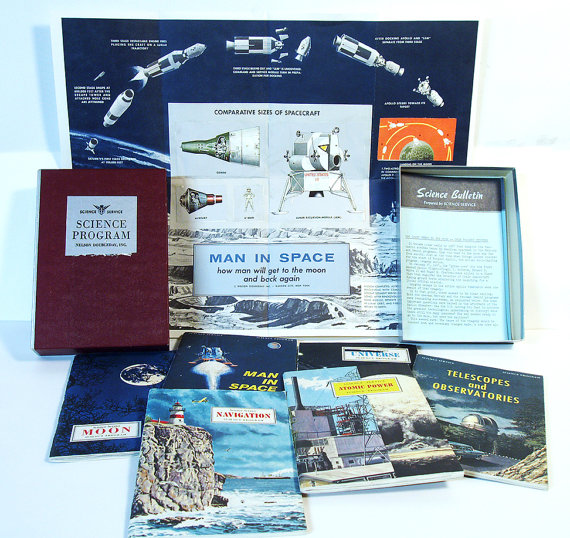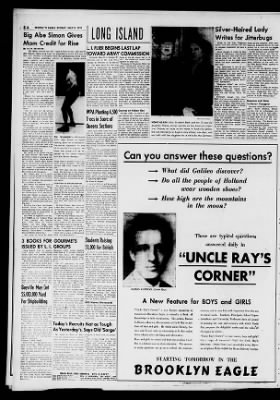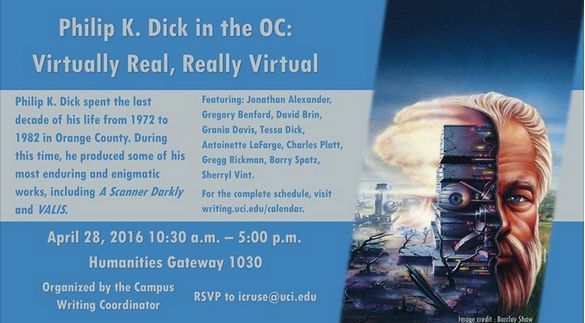(1) FARSCAPE ON BIG SCREEN. ComicBookMovie.com reports “Rockne O’Bannon Officially Confirms FASRSCAPE Movie”.
After years of rumours, Rockne O’Bannon has finally confirmed that a Farscape movie is actually happening. The show was cancelled back in 2003 and a mini-series titled Farscape: The Peacekeeper Wars was aired in 2004 to provide closure to the fans but it appears we shall be getting more Farscape in the near future. Confirmation comes from TV.com’s Ed Shrinker who had a friend that attended the Showrunners panel at Wondercon which O’Bannon was a part of.
(2) BEAGLE COMING TO BALTICON. Peter S. Beagle will be a Special Guest of Honor at Balticon 50, taking place over Memorial Day weekend in Baltimore, MD.
“It’s Peter’s birthday, but the fans are getting the gift,” says Beagle’s attorney, Kathleen Hunt.
(3) AXANAR IS DOCKED. In “’Star Trek: Axanar’ Fan Film Docked After Copyright Suit from CBS/Paramount”, Elizabeth Howell gives Space.com readers a status report on the lawsuit.
… According to Peters, Winston & Strawn subsequently filed a motion to dismiss the lawsuit. CBS and Paramount responded, he said, by amending portions of the complaint. The new complaint alleges that copyrights were violated in matters such as the pointy ears and “distinctive eyebrows” of Vulcan, the gold-shirt uniforms of Federation officers, and the Klingon language, according to documents posted by The Hollywood Reporter on March 13.
New motion to dismiss
In the meantime, the production of “Axanar” is on hold pending the result of the lawsuit. If the lawsuit is resolved in the film’s favor, Peters said, production will still be delayed, as it would take a couple of months to organize everything, including coordinating the actors’ schedules and resuming work on elements such as the costumes.
Winston & Strawn filed a new motion to dismiss on March 28. CBS and Paramount have yet to file a response in court.
“The motion provides examples as to how CBS and Paramount overreach in what they claim are elements protected under copyright, and fail to be specific as to exactly which copyrights have been infringed upon; and, in the case of the potential feature film Axanar, claims of alleged copyright infringement cannot be made against a film that doesn’t yet exist,” read part of an Axanar statement on the motion to dismiss.
(4) A THOUSAND WORDS IS WORTH A PICTURE OF A CAT. At Camestros Felapton’s blog, Timothy the Talking Cat has his claws out: “Ctrl-Alt-Delete – A Reviewing”.
[Timothy] No sarcasm. Don’t forget, this time I control the narrative. I can make you say anything. Say “I’m a poo-poo head”
[Camestros] I’m a poo-poo head.
[Timothy] OK say I’m a fish’s butt.
[Camestros] You are a fish’s butt.
[Timothy] Oops – forgot the speech marks. So back to the book – naturally you hated it?
[Camestros] You know I actually enjoyed quite a bit of it.
Despite what you might assume from this exchange, they spend most of their time reviewing books. But as today’s Top Level Poster I can quote whatever part I like.
(5) ICE FIVE. Theory: Game of Thrones is science fiction, not fantasy: “This Is the Most Insane and Compelling Theory for How the Wall in Game of Thrones Stands”. Esquire’s John Maher delves into the ideas advanced by vlogger Preston Jacobs.
Let’s go back to the Wall, a prime example in the case of Game of Thrones. Maybe there is some sort of magic keeping it up. “Or maybe,” Jacobs suggests, “there’s some sort of refrigeration unit.”
It seems farfetched, until you start digging deeper—and Jacobs, an auditor for the U.S. State Department by day, is an expert at doing just that. After re-reading the series a couple of years ago, he jumped right into reading the vast majority of Martin’s extant works, including every story that’s taken place in the author’s most frequently visited setting, a shared universe called the Thousand Worlds….
The Long Night itself seems to hint at the explanation for how this world—as Jacobs and other theorists do, let’s call it Planetos—became the way it was. A winter that lasts for a generation seems pretty hard to believe, even in a world with seasons as crazy as those on Planetos. In the first season of Game of Thrones, Tyrion discusses with Maester Aemon and Lord Commander Mormont the longest winter he’d ever lived through, and mentions it lasted three years. But as Jacobs points out, there is such a thing as a generation-long winter in the real world: a nuclear winter.
In the Thousand Worlds universe, humanity is at perpetual war with multiple hive-minded species—a form of life that pops up in A Song of Ice and Fire as well, and which Jacobs explores in detail in one of his theories. During this endless war, the hive-minded races typically destroy human worlds using nuclear weapons, wait a hundred years for the dust to settle, and then invade and enslave the survivors. And in the interim, something familiar happens, as it does on High Kavalaan, a planet in Martin’s first novel, Dying of the Light.
“I think the book that really made me think Westeros could be post-apocalyptic was Dying of the Light,” says Jacobs. “When he started writing about nuking people, with everybody hiding in mines and founding their own houses and holdfasts, it just occurred to me that the Long Night could be a nuclear winter.”
(6) HEINLEIN ON THE LINE. At the MidAmericCon II site, Toastmaster Pat Cadigan has blogged her fannish origin story.
Forty years ago, in the spring of 1976 in Lawrence, Kansas, the phone rang in the late afternoon, about an hour and a half before I had to go and teach a belly-dance class. When I picked up, a deep, warm-as-a-woolly-blanket man’s voice said, ‘Hello, Mrs. Cadigan. This is Robert Heinlein.’
And I freakin’ died.
Seriously; I died. This is my afterlife. Isn’t it great?
Okay, let me back up a little….
(7) HUGO TIME. It’s no coincidence that Hugo Administrator Dave McCarty and staff are doing a lot of work just about now:
First, on behalf of the Hugo administration staff and all the rest of the folks making preparations to run MidAmeriCon II, I want to thank all of the people who participated in our Hugo and Retro Hugo nomination processes. There were over 4,000 of you and that is a new record participation by quite a large margin.
There’s a large number of tasks we have to do to administer the Hugos. Identifying eligible nominators and voters, setting up servers and web pages to handle secure nominations and voting, answering hundreds of questions about the process for the members, making sure everyone’s nominations are counted appropriately even if they don’t use the same name for something they loved that all the other folks who loved it used or nominated it in the wrong category accidently, locating and contacting the potential finalists to get their acceptance and inform them of how the process works and what to expect, coordinating with convention events staff to run the awards ceremonies and pre-receptions, and numerous other tasks. The previous run on sentence would be staggeringly large if we tried to give a full accounting of everything the awards administration entails. It can be fun, it can be exhausting, and it can even sometimes be frustrating. When we do a good job, though, it’s very rewarding.
(8) HUGO LOVE FROM WORDPRESS. Kevin Standlee’s The Hugo Awards website came in for recognition today —
Featured @Jetpack site — the site of @TheHugoAwards, sci-fi's most prestigious award: https://t.co/t37s12jSWf pic.twitter.com/Pm89fNIe2E
— WordPress Discover (@WPDiscover) April 20, 2016
(9) NEIL GAIMAN. Gaiman on mourning Pratchett — “Good Omens, Cheap Seats, and the Memorial”.
I haven’t blogged for a long time, but right now I’m on a train, and it feels like a good time to catch up. This morning I was interviewed by Charlie Russell for his documentary on Terry Pratchett. (Charlie made the previous BBC Terry Pratchett documentaries, Living With Alzheimer’s, Choosing to Die, and Facing Extinction.) We did it in a Chinese restaurant in Gerrard Street, because Terry and I had first met in a Chinese restaurant, in February 1985. It was easy and pleasant, and then suddenly it wasn’t. I was talking about the last time I’d seen Terry, and what we said, and I found myself crying uncontrollably, unable to talk. And then I pulled it together, and we carried on….
The memorial the other night was beautiful. I wore my mourning frock coat that Kambriel made for me, and I went out that afternoon and bought a white shirt and a black tie. (Actually, I bought four shirts, which, given how often I wear white shirts, should take me easily to the end of my lifetime.)
I read the introduction to A Slip of the Keyboard, which I’d written for Terry while he was alive. I got sad at the end but that was fine. And I held it together just fine when Rob, Terry’s amazing right-hand man, presented me with a big black author’s hat Terry had left me. I couldn’t put it on, though. I wasn’t ready for that. (I tried it on later, in the dressing room. I looked, to my mind, like a rabbinical cowboy assassin. Not that there’s anything wrong with that.)…
(10) MORE LIKE INDIE FOR SMART PEOPLE. Sarah A. Hoyt, in “Going Indie For Dummies: You Lays Down Your Money” at Mad Genius Club, begins her survey of professional services available to indie authors with a warning –
I cannot emphasize enough that you should at all costs avoid paying money up front to have any of the necessary stuff done to your book. Particularly if your indie ebook is a short story or a novella, it’s QUITE possible you’ll never see that money again….
Then she follows with a lot of practical experience. (And no, I am not picking this quote as a setup for predictable comments about Baen copyediting, but because writers in general suffer through this.)
b) Copy editing: even houses confuse this with “editing” and I’ll get a list of typos or repeated words from editors who are supposed to be doing high-grade structural. It’s what most people think of as “editing.”
PLEASE make sure you get a copy editor who actually knows what he/she is doing. Again it is too easy for a copy editor to screw with a book by making the wrong choices, and/or not getting what you’re trying to say. (I recently had a copy edit that suggested changing “calloused hands” to “callous hands” — yes, her hands are cold and unfeeling. What the actual F?) so several steps:
1- look for a copy-editor with references and call/email those references where the copy-editor can’t hear/read and ask for the real skinny and how hard they are to work with.
2- ask them what manual of style they use. If you get back “manual?” or “I just use sensible grammar” and this is a paid copy-editor it’s time to bail, ladies, gentlemen and fuzzy toys. There are many ways of doing things including punctuation (unlike what your grammar teacher told you.) I favor, for my own checking, Strunk and White which has a slightly British flavor. Most publishing houses use Chicago Manual of Style. Baen uses Words to Print (I think that’s the title.) You want to make sure your books are consistent, so make sure your copyeditor uses a style you can live with.
(11) TODAY IN HISTORY
- April 20, 1841 — Edgar Allen Poe’s story “The Murders in the Rue Morgue” first appears in Graham’s Lady’s and Gentleman’s Magazine. The tale is generally considered to be the first detective story.
(12) TODAY’S OTHER HISTORY LESSON. Hmm. Good point.
I always thought it was ironic Andrew Jackson was on a bank note, considering his opinion of the national bank.
— John Scalzi (@scalzi) April 20, 2016
(13) TODAY’S BIRTHDAY BOYS
- Born April 20, 1937 — George Takei, age 79 today.
- Born April 20, 1964 – Andy Serkis
(14) IN BOOKS TO COME. “Andy Weir, Author of The Martian, Shares Details About His Next Novel” at The Smithsonian. Here’s a guy nobody will ever accuse of having SJW tendencies.
Your next book will have a woman as the central character. Given that “gender wars” in science fields is still a contentious topic, why did you decide to go with a lady lead? What kinds of challenges does your protagonist face, and does her gender play any role in those challenges?
I don’t take part in any political debates. So I’m certainly not trying to make a point by having a female lead. She’s just a character I came up with that I thought was cool, so she’s the lead.
The book is another scientifically accurate story. The main character is a low-level criminal in a city on the moon. Her challenges are a mix of technical/scientific problems, as well as juggling personal interactions—staying a step ahead of the local police, working with shady and dangerous people to do illegal things.
She doesn’t encounter any distinctly “female” challenges. There’s no love plot. And the story takes place in a future society where there is practically no sexism.
(15) NOT JUST TANG. The BBC discusses “Four ways NASA is teaching us how to live more sustainably”.
2. Clean water
In space, water is in short supply, so Nasa has developed an innovative way to filter waste water on the ISS using chemical and distillation processes. This lets it turn liquid from the air, sweat and even urine into drinkable H2O.
In fact, since 2008, more than 22,500 pounds of water have been recycled from urine alone on the ISS – something that would have cost more than $225m (£160m) to launch and deliver to the station from Earth.
“Most people are horrified when they see what we drink!” says Ms Coleman. “But the filtered water up there just tastes beautiful, it really is delicious.”
Nasa has since licensed the technology to companies on Earth, which have created portable filters for use in places where fresh drinking water is scarce.
Filters produced by US firm Water Security Corporation, for example, have been installed in villages across Mexico and Iraq, allowing residents to purify water from contaminated sources.
(16) RILEY INTERVIEWED. David Dubrow conducted an “Interview With David A Riley” after the author dropped off a Horror Writers of America award jury last week amidst controversy.
Why did you withdraw from the jury of the Bram Stoker Award for Best Anthology?
Because, as I saw it, that was the best thing to do for the good of the HWA. There is nothing prestigious or glamorous about being a juror. It does involve a lot of unpaid, unseen, arduous work reading an enormous number of books by authors or publishers or, in the case of anthologies, editors, keen to have their books included amongst the finalists for the Stoker awards. Of course the juries cannot add more than a few books, but it does mean reading all those submitted, good, bad or indifferent. I know from when I was a juror for First Novels this can be a hell of a chore. Standing down, therefore, was easy – it saved me a lot of hard work, some of it far from enjoyable. I only put my name forward because the HWA sent out a last minute email appealing for volunteers from active members for this position. I thought I was helping the HWA by stepping forward, never realising the reaction stirred up by certain individuals, some of whom already had a personal grudge against the HWA and are not even members….
Are you still part of the UK National Front?
I resigned in 1983 and have not been involved since.
A lot of people have characterized you as a fascist. Would you say that’s a fair description of your politics?
No. It’s an easy label to flash around, usually by those who are fascists themselves, particularly from the left. Fascists don’t believe in free speech and try to suppress it for their opponents. I have never in my life tried to do that. They are also prepared to use physical violence against their political opponents. I was never involved in anything like that. I would add that during the time I was involved in the party any member who associated with a neo-nazi group, either in Britain or overseas, faced expulsion. This, I can confirm, was enforced.
(17) EISNER AWARD MANGA. Brigid Alverson reviews six works in her post “This Year’s Eisner-Nominated Manga Shows What the Medium Can Do” at B&N Sci-Fi & Fantasy Blog.
Nominees for the Eisner Awards, the top honors in the comics industry, were announced on April 19. This year’s nomnees in the manga category (technically, “Best U.S. Edition of International Material—Asia”) offer a range of different types of manga, from genre comedy to poignant literary works. As a former Eisner judge myself, I know how hard the choices are, and this year’s slate is exceptionally good. All these series are accessible to non-manga readers as well as longtime fans. Let’s dive in and take a look!
Assassination Classroom, by Yusei Matsui This was the surprise nominee, because it’s not exactly a highbrow series, though it is wickedly funny. The setup is totally over the top: a class of misfit high school students are assigned the job of killing their teacher, Koro-sensei, an octopus-shaped alien who has announced he will destroy the earth at the end of the school year. Armed with weapons that are harmless to humans but deadly to their teacher, they study his weaknesses and plot new attacks, and new assassins join the class as the series goes on. What makes it so fun (and so weird) is that Koro-sensei is actually a really good teacher, and he uses his superpowers to help his students as much as to evade their attacks. He’s quirky, overly fond of gossip, a bit self-indulgent, and he often finishes a face-off with an opponent by doing something silly like giving them a manicure. This is a series that shonen fans will particularly enjoy, as there are a lot of inside jokes about the conventions of the genre, but it’s also a fun action comedy for anyone willing to go all in on suspension of disbelief. There is a darker side to Koro-sensei, and occasionally he lets the jovial mask slip, adding a bit of edge. The judges nominated volumes 2-7 of this series for the award.
(18) STEM INTO STEAM. Wil Wheaton has posted “My speech to the 2016 USA Science and Engineering Festival”.
Which brings me to funding.
You’re never too young for science – getting children interested in the world around them, and asking them to try and figure out how things work is a fundamentally good idea. Curious children will naturally gravitate towards STEAM subjects. Let’s encourage that and make sure that a child who wants to explore that particular part of our world has everything she needs to get there, and keep learning about and making awesome things when she leaves. This is and will continue to be a challenge. Despite the clear and undeniable benefits of a comprehensive education, including science education, not only to individuals but to our entire society, we have allowed the funding of our schools to become part of the culture wars. This is as disgraceful as it is predictable. When so many of our poorly-named “leaders” deny scientific consensus on everything from climate change to vaccines, a scientifically literate and well-informed populace can be tremendously inconvenient to them and theiir corporate owners. Well … good. Let’s be inconvenient to them. Let’s educate and empower a generation who will be real leaders, and carry our nation into the future.
We all know that it’s possible to fund STEAM education. The money is there, it’s just being spent on other things. Making enough noise and applying enough sustained pressure to change this will not be easy. It will actually be quite hard. But when has America ever shied away from doing things that are hard? Everything worth doing is hard, and President Kennedy said as much when he challenged our nation to go to the moon. Right now, decades later, every single one of us has benefitted in some way from that commitment. Right now, a generation of future scientists can look to MARS and beyond, because nearly fifty years ago, we did whatever it took to go to the moon.
Why aren’t we doing that today? Because it’s hard?
(19) 2016 SPECULATIVE FICTION EDITORS. The Book Smugglers are already “Announcing the Editors of Speculative Fiction 2016 & Call for Submissions”.
In which we announce the editors for the 2016 edition of the award-winning collection Speculative Fiction
As you probably know by now, we are the new publishers of the ongoing editions of Speculative Fiction: The Best Online Reviews, Essays and Commentary – a collection that celebrates the best in online Science Fiction and Fantasy nonfiction. We are currently hard at work on the publication of SpecFic ’15 – edited by Foz Meadows and Mark Oshiro – and we feel it is time to move on to the next very important step for next year: announcing the two new editors for 2016.
Since its inception in 2012, the Speculative Fiction collection has been envisioned as an annual publication, curated by a new pair of editors each year. Each incumbent pair is also given the weighty task of selecting the next year’s editors.
Today, we are extremely proud to finally announce the editors of Speculative Fiction 2016: Liz Bourke and Mahvesh Murad!
Apparently items for the 2015 collection needed to be submitted to the editors? Well, I didn’t send in anything from File 770, so that’s that.
(20) CELEBRITY VERSIONS OF BB-8 AUCTIONED. Til April 24 you can bid on a variety of BB-8 droids that have been kitted up by celebrities. 100%* of the proceeds from this auction will be donated to Great Ormond Street Hospital Children’s Charity, on behalf of Force For Change.
The Londonist ran an article and a gallery of photos.
We enjoyed the recent Star Wars film. But, like many, we couldn’t help thinking that BB-8 would look far more fetching dressed up as the globus cruciger from the Crown Jewels, or else painted in the colours of the Union Flag, tarted up like a teapot, or made to look like one of the Beatles.
Our wishes are fulfilled at a new exhibition and charity fundraiser. The cutesy droid has enjoyed a makeover from dozens of artists and celebrities, with the best efforts on show at White Rainbow Gallery (47 Mortimer Street) until 21 April.
Contributing celebrities include Daisy Ridley, John Boyega, Mark Hamill, Anthony Daniels, Warwick Davis, Simon Pegg (responsible for the Beatles droid, above), Paddy McGuinnes, Jonathan Ross, Nicola Adams and the band Years and Years. Each has daubed the droid with a design celebrating an element of British culture, from Robin Hood to the Sex Pistols.
(21) LOOK UP IN THE SKY. Alastair Reynolds is in awe by the end of a session of starwatching (“Pattern Recognition”) —
The light I caught had travelled 25,000 years to reach my telescope. If there’s ever a day when that sort of thing doesn’t send a shiver down my spine, please feel free to shoot me.
[Thanks to John King Tarpinian, JJ, Chip Hitchcock, Cat Eldridge, Will R., Steven H Silver, and Martin Morse Wooster for some of these stories. Title credit goes to File 770 contributing editor of the day Brian Z.]





































